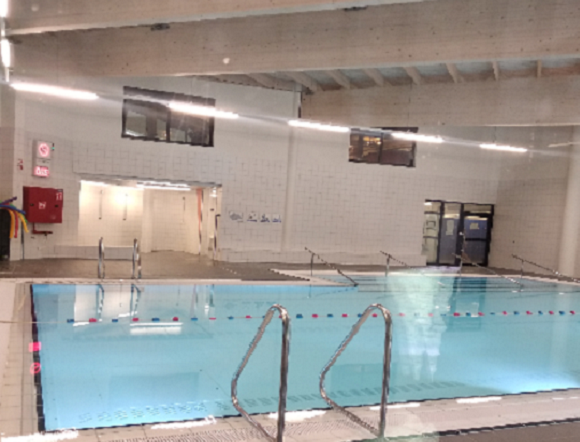
"You need 3 m² of swimming water surface per city inhabitant," says Dirk van Wiele, head of the Sporting Infrastructure Administration at the Free University of Brussels (VUB). Currently, the city of Brussels managed to reach a total of 60 % of this Flemish rule requirement. There is a clear shortage of swimming water possibilities.
By Geraldine Gomez Ruiz (Edited by Dino Subašić)
This is why the VUB has taken it upon to renovate the pool as it adds up to 12 % of swimming water possibilities to the inhabitants of Brussels. With the greener goals in mind that are strived for in the European Union, the University managed to gather enough funds by setting a budget together with the European Regional Development Fund, local governments, private partners, and citizens who donated by buying 50 euro virtual tiles for the pool. The goal was to build the most sustainable pool in Europe.
The pool has proven to be a successful project and an example of how innovation takes willingness and time to do things differently. It took half a year to get the water to stabilize in order for it to be safe enough for its swimmers. A big part of the engineering was the marriage of the UFRO which creates the flattest water mixed with salt electrolytes. The water had to be disinfected enough for it to be safe for people, but not too much because that would be harmful to swimmers. In the latter case, for example, the acid would turn someone’s blonde hair green, says Sven De Bruyn, engineer of the Free University of Brussels.
Social impact focus points
Now that the pool is up and running, the focus lies more on making the pool accessible for a range of various groups in society: the elderly, Muslim women, families, handicapped people in wheelchairs or paralyzed people, even naturalists.
Another social benefit of the sports facility was created during the pandemic: a buddy system to combat loneliness. It helps because there is no language barrier, your status in society doesn’t matter, the only thing that matters are the rules of the game.
Furthermore, the new initiative called Swimove, teaches children how to swim and survive in the water. The lessons are taught through pictures due to the children’s multicultural backgrounds. It is easier to explain to young kids what movements they should do through images instead of explaining it in technical terms in a language that might not be their mother tongue. This method of teaching seems to be working effectively as well. The goal is for the children to keep swimming into adulthood. In this manner not only is the pool sustainable, but so are the activities. The importance is put on pleasure and safety which are important building stones for lifelong swimming.
The multipurpose of the pool is also one of the added values to students on campus as they are researching the benefits of swimming. Professor Kristine De Martelaer of Physical Education at the University of Brussels says that swimming might have an increased benefit on us due to the direct contact with the element of water.
Improvement points
The University of Brussels can be used as an example of how other pools can be built in Brussels and other regions and cities within Europe. It is perfectly understandable for the first pool to be at a university campus, this is where innovation takes place. It is commendable that this new project came to fruition in such a record time, namely in 390 days. As explained by Wiele: “We are the fastest project in demolishing an old pool and building a new pool. There were only 16 months between the last day on which someone swam at the old pool and the day in which they welcomed a swimmer into the new pool. Two summer holidays and a school year”.
In the future, it would be advisable for the EU to fund a pool in less well-off regions, in this manner they can reach groups in society who are in need of the social benefits of a publicly funded pool. Additionally, the location should be more accessible for handicapped or paralyzed people for example. The University is advertising the pool to a broad range of groups in society, however, admittedly they said that if the infrastructure to reach the pool is full of obstacles, the chances of getting people to enter the pool decreases.



